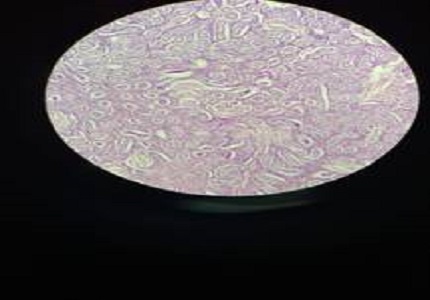Case report of sertoli-leydig cell tumor of bilateral ovaries in a woman with 46XYkaryotype
Abstract
Sertoli-Leydig Cell Tumors are rare constituting less than 0.5% of ovarian neoplasms and usually unilateral. Average age of presentation is 25 years.We report the case of a 23-year-old unmarried woman who presented with primary amenorrhea and 8 months history of intermittent pain over left lower abdomen. Transvaginal scan revealed rudimentary uterus with left ovarian cyst with mural nodules. Cytogenetic study revealed 46XY karyotype. Histopathological examination of specimen received after surgeryshowed well-differentiated Sertoli-Leydig Cell Tumor in sections from bilateral ovaries and Serous Surface Papilloma in a section from left ovary.Diagnosis is based on morphological features. Prognosis depends on stage and degree of differentiation.
Downloads
References
Young RH, Scully RE. Ovarian Sertoli-Leydig cell tumors.A clinicopathological analysis of 207 cases.Am J SurgPathol.1985Aug;9(8):543-69.
Dietrich JE, Kaplan A, Lopez H, Jaffee I. A case of poorly differentiated Sertoli-Leydigtumour of the ovary. J PediatrAdolesc Gynecol. 2004 Feb;17(1):49-52.DOI: https://doi.org/10.1016/j.jpag.2003.11.006.
K. M. Zanotti, “The clinical manifestations and diagnosis of Sertoli-Leydig cell tumors of the ovary,” CME Journal of Gynecologic Oncology 2002; 7:129–133.
Zaloudek C, Norris HJ. Sertoli-Leydigtumors of the ovary.A clinicopathologicstudy of 64intermediate and poorlydifferentiatedneoplasms.Am J SurgPathol.1984 Jun;8(6):405-18.
Roth, L.M., Anderson, M.C., Govan, A.D.T., Langley, F.A., Gowing, N.F.C., and Woodcock, A.S. Sertoli–Leydig cell tumors. A clinicopathologic study of 34 cases. Cancer. 1981 Jul 1;48(1):187-97. DOI: https://doi.org/10.1002/1097-0142(19810701)48:1%3C187::AID-CNCR2820480130%3E3.0.CO;2-1.
Weng C.S., Chen M.Y., Wang T.Y., Tsai H.W., Hung Y.C., Yu K.J., Chiang Y.C., Lin H., Lu C.H., Chou H.H. Sertoli–Leydig cell tumors of the ovary: a Taiwanese gynecologic oncology group study.Taiwan. J. Obstet. Gynecol. 2013 Mar;52(1):66-70. doi: https://doi.org/10.1016/j.tjog.2012.03.001.
V. W. Chen, B. Ruiz, J. L. Killeen, T. R. Coté, X. C. Wu, and C. N. Correa, “Pathology and classification of ovarian tumors,” Cancer, vol. 97, supplement 10, pp. 2631–2642, 2003.
Nisolle M, Kridelka F, Fridman V, Claudot A, Lorquet S, Foidart JM. [A bilateral dysgerminoma: a rare presentation of the Swyer syndrome]. Rev Med Liege. 2005 Sep;60(9):703-6.
Marrakchi A, Belhaj L, Boussouf H, Chraibi A, Kadiri A. [Pure gonadal dysgenesis XX and XY: observations in fifteen patients]. Ann Endocrinol (Paris). 2005 Dec;66(6):553-6.
Ben Romdhane K, Bessrour A, Ben Amor MS, Ben Ayed M. [Puregonadal dysgenesis with 46XYkaryotyping (Swyer'ssyndrome) with gonadoblastoma, dysgerminoma and embryonal carcinoma].Bull Cancer. 1988;75(3):263-9.
Kriplani A, Agarwal N, Roy KK, Manchanda R, Singh MK. Laparoscopic management of Sertoli-Leydig cell tumors of the ovary.A report of two cases.J Reprod Med. 2001 May;46(5):493-6.
RimpyTandon, M, PoonamGoel, Pradip Kumar Saha, NavneetTakkar, RPS PuniaA Rare Ovarian Tumor – Sertoli-Leydig Cell Tumor With Heterologous Element. MedGenMed. 2007; 9(4): 44.



 OAI - Open Archives Initiative
OAI - Open Archives Initiative


